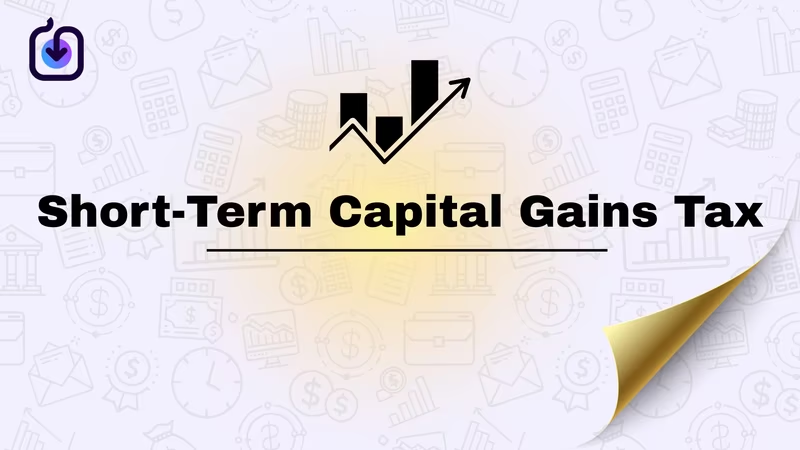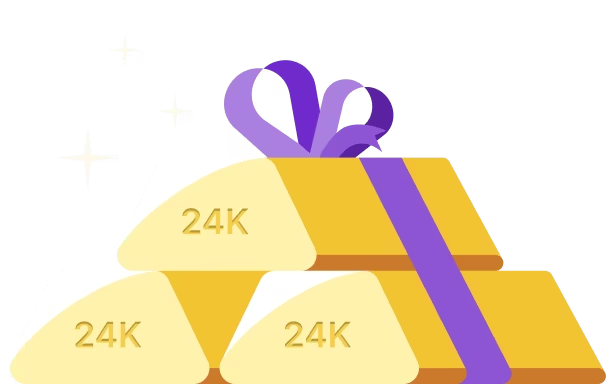What is the Short Term Capital Gains (STCG) tax?
It's quite important to know about the short-term gains tax if you want to invest.
Short-Term Capital Gains (STCG) is the money you make when you sell something you owned for a "short" time.
The government takes a cut of this profit, and the tax you pay on it is called the Short-Term Capital Gains Tax.
Investors are very interested in this tax since it is usually greater than the Long-Term Capital Gains (LTCG) tax. Three questions will help you comprehend it better:
How long do I have to keep my asset?
How can you figure out the tax rate for this asset?
How can I lawfully lower this tax?
This guide will answer all of these questions, with an emphasis on the new rules that will go into force with the budget.
New Short-Term Capital Gains Tax Rates
The laws are easier to understand now that the Budget 2024 is out; however, the sort of asset you sell drastically affects the tax on short-term capital gains.
The old groups for 12, 24, and 36 months have been made simpler. You need to know about the new system.
If you sell an asset on or before the date below, it is "short term."
| Asset Type | Short-Term Holding Period | STCG Tax Rate |
| Listed Indian Stocks (Equity) | 12 months or less | 20% (flat rate under Sec 111A) |
| Equity Mutual Funds (Indian) | 12 months or less | 20% (flat rate under Sec 111A) |
| Real Estate (Land, Building, House) | 24 months or less | Added to your income & taxed at your slab rate |
| Physical Gold & Silver | 24 months or less | Added to your income & taxed at your slab rate |
| Unlisted Indian Stocks | 24 months or less | Added to your income & taxed at your slab rate |
| Gold ETFs & Sovereign Gold Bonds (SGBs) (Sold on exchange) | 12 months or less | Added to your income & taxed at your slab rate |
| US Stocks & Foreign Assets | 24 months or less | Added to your income & taxed at your slab rate |
Important Point: Pay attention to the two different ways taxes are handled. The tax rate on gains from Indian equities and equity funds is now a flat 20% (it was 15% before the budget).
Gains from most things (including property, gold, debt funds, and US equities) are added to your normal income and taxed at the rate that applies to your income tax bracket (for example, 0%, 5%, 10%, 20%, or 30%).
The Most Confusing Asset: Debt Mutual Funds
Now, the taxes on debt funds are determined by when you put your money in. This is the most important and most searched-for issue for investors.
1. For debt funds bought before April 1, 2023, the new 24-month rule applies.
If you sell in 24 months or less, the gain is added to your income and taxed at your slab rate.
If you sell after 24 months, it's a long-term gain and you'll pay 12.5% in taxes (without indexation).
2. For Debt Funds Bought on or after April 1, 2023
The regulations are easy to understand, yet they are strict: It doesn't matter how long you retain them (even 5 or 10 years); all gains are classified as short-term capital gains.
Your profit is always added to your income and taxed at the rate that applies to you.
There are no longer long-term capital gains on new investments in debt funds.
How to Figure Out and Report Your Short-Term Capital Gains
This is a question that everyone wants to know the answer to. It's easy to figure out the capital gains tax on short-term profits.
- Step 1: Figure out how much you made from the sale - The net sale price is the full sale price minus the brokerage, STT, and other costs of selling.
- Step 2: Figure out your STCG - The STCG is the difference between the net sale price and the cost of acquisition.
For example: You paid ₹50,000 for 100 shares of XYZ Ltd. (the cost of buying them). You sold them eight months later for ₹75,000, which was the full transaction price. You paid ₹500 in fees for the broker and other things.
- Net Sale Price: ₹75,000 - ₹500 = ₹74,500.
- Your STCG is ₹74,500 - ₹50,000, which is ₹24,500.
- Your Tax: The tax on these listed equity shares is a flat 20% on the profit because they have been held for less than 12 months.
Tax Due = 20% of ₹24,500 = ₹4,900 (plus any relevant cess)
How to Include Short-Term Capital Gains in Your ITR
If you have any capital gains, you can't use the standard ITR-1 (Sahaj) form.
If you don't have any business income, you need to utilize ITR-2. If you do have business revenue, you need to use ITR-3.
You will list all of your sales on the "Schedule Capital Gains (CG)" in the ITR.
Ways to Save on Taxes
This is the most crucial part. How can you lawfully lower your short-term capital gains tax bill?
"Is there a 'Wash Sale' Rule in India? (Tax-Loss Harvesting)"
No, India does not have a "Wash Sale" rule.
A "wash sale" is a restriction in the US that stops you from selling a stock for less than you paid for it and then buying it back right after to claim the tax loss.
This is possible in India. You can sell a stock that is losing money on March 31st to "harvest" the short-term capital loss (STCL) and then buy it again the next day.
You can then utilize this Short Term Capital Loss to lower your Short Term Capital Gains, which will lower your taxable income.
The Set-Off Rules for Tax-Loss Harvesting:
You can use Short-Term Capital Loss (STCL) to lower both Short-Term Capital Gains (STCG) and Long-Term Capital Gains (LTCG).
You can only use Long-Term Capital Loss (LTCL) to offset Long-Term Capital Gains (LTCG).
You can carry forward any loss that you didn't use for 8 years.
Disclaimer: India's Rules Against Avoiding Taxes. There is no wash sale regulation, but you should know about "bonus stripping" and "dividend stripping." If you buy a stock shortly before a bonus issue and then sell the original shares at a loss within nine months, the loss will not be permitted for tax purposes.
2. Is it possible to get a Section 54 exemption on STCG?
This is something that property sellers often get wrong.
No. You can only use the Section 54 exemption (putting the money you made from selling your house into a new house) for LONG-TERM capital gains.
You can't use this exemption if you sell your residence within 24 months, which is a short-term gain. Your slab rate will apply to the whole profit, which will be added to your income.
STCG can get exemptions under Section 54B (for agricultural land) and Section 54D (for forced acquisition), but not for anything else.
3. Can I Use My Basic Exemption Limit to Pay STCG?
Of course you can! A lot of individuals don't see this as a big benefit.
Your tax-free income is the basic exemption level, which is ₹3 lakh under the new tax system or ₹2.5 lakh/₹3 lakh/₹5 lakh under the old system.
It's easy for STCG, which is taxed at the slab rate, like money from property or loan funds. The gain is included in your total income; therefore, it immediately gets the basic exemption slab.
For short-term capital gains (STCG) on equities (Sec 111A at 20%).
You can use the leftover (unexhausted) limit to lower your STCG from stocks if your overall income (such as salary, interest, etc.) is less than the baseline exemption level.
For example:
Your salary after taxes is ₹2,00,000.
Your STCG from stocks is ₹1,50,000.
The new system sets your basic exemption ceiling at ₹3,00,000.
You have reached the limit with your salary of ₹2,00,000. You still have ₹1,00,000 of your tax break left. You can use this to lower your stock gains.
Taxable STCG = ₹1,50,000 - ₹1,00,000 (limit not used) = ₹50,000
You only have to pay tax on ₹50,000, not the whole ₹1,50,000.
Note: Only people who live in India can get this advantage.
4. Can I use 80C deductions to lower my STCG?
It depends on what kind of STCG it is.
No STCG from Stocks/Equity MFs (Sec 111A). Under 80C, 80D, and other rules, you can't take deductions for these gains.
Yes, STCG can come from various assets like property, gold, and debt funds. You can use your 80C deductions to lower your entire taxable income, which includes this gain, because it is applied to your "Total Income."
Special Cases (Cryptocurrency and US Stocks)
These are two of the most common questions people have about current investments.
1. What are the tax rules for crypto? Is it STCG?
No. Cryptocurrency gains are NOT capital gains. The government developed a new category for "Virtual Digital Assets" (VDAs), which encompasses all cryptocurrencies and NFTs.
The tax rate is A flat 30% tax on all profits, plus a cess or surcharge.
No STCG/LTCG: It doesn't matter how long you hold it. It doesn't matter if you hold for one day or ten years; the tax is 30%.
No Deductions: You can only take off the cost of what you bought. You can't have any additional costs, such as internet bills, computer expenditures, etc.
No Loss Set-Off: This is the strictest restriction. You can't use a loss from a VDA to offset any other revenue, not even profit from another VDA. You can't carry it forward either.
TDS: A 1% TDS (Section 194S) keeps track of all transactions.
2. How does India tax STCG in US stocks like Apple and Google?
For an Indian resident, the following taxes apply to gains from foreign stocks:
They are considered "unlisted assets" during the holding period.
The holding duration for the short term is 24 months or less. (This is longer than the 12-month timeframe for Indian stocks.)
Tax Rate: The short-term capital gains (STCG) you make from US stocks are added to your income and taxed at the same rate as your income.
It doesn't get the flat rate of 20%.
DTAA Advantage: The Double Taxation Avoidance Agreement (DTAA) between India and the US means that you don't have to pay capital gains tax in the US. You just have to pay taxes in India, where you live.
Disclaimer: Tax regulations are hard to understand and can change. This article is simply meant to give you information. For advice that is relevant to your financial situation, please talk to a licensed chartered accountant or tax counselor.










